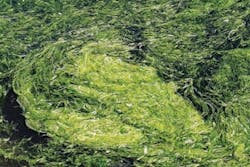Microcystin: Danger in the Lake
About the author: Stefan Buck is business unit manager for NSF Intl.’s Filtration Program. Buck can be reached at [email protected].
Cyanotoxins are chemical contaminants in surface water formed by cyanobacteria. Also known as blue-green algae because of their ability to use photosynthesis like plants, cyanobacteria create oxygen as they feed and grow from plentiful nutrients and sunshine.
Under the right conditions, blue-green algae can grow exponentially to form “blooms.” Warm weather combined with an influx of the right nutrients, such as phosphates from agricultural runoff, creates the ideal environment for a harmful algae bloom (HAB). These blooms can lead to toxic concentrations of cyanotoxins, especially microcystin, which can be harmful to humans. HABs have been identified across the globe, from Lake Erie in the U.S., to Lake Koetshuis in the Netherlands, to Lake Taihu in China.
Many municipalities draw part or all of their source water from nearby lakes or rivers. If there is an HAB present in the source water, concentrations of cyanotoxins can enter the public water supply and overwhelm the municipal treatment system. Unlike bacteria, cyanotoxins remain unaffected by boiling water. The detection of these compounds in drinking water and the recent actions of the U.S. Environmental Protection Agency (EPA) have created significant consumer and regulatory interest in point-of-use (POU) products that can effectively treat microcystin contamination.
EPA has established drinking water limits for microcystin of 0.3 ppb for children under 6 and 1.6 ppb for everyone else. These levels were determined in conjunction with Health Canada. The health advisory values set by EPA are based on exposure for 10 days.
Exposure to microcystin above these levels can cause a range of symptoms, including fever, headaches, diarrhea and vomiting, as well as liver and kidney damage in severe cases. If the concentration of microcystin in drinking water exceeds these limits, the water utility must issue a public water advisory notifying the public the water is not safe to drink.
Reducing Microcystin in Drinking Water
As scientific and toxicological understanding of cyanotoxins increased, microcystin became more readily available for testing purposes. This led scientists and public health experts at NSF Intl. to develop NSF Protocol 477: Drinking Water Treatment Units – Microcystin to verify the effectiveness of residential water treatment technologies’ ability to reduce microcystin in drinking water to safe levels. NSF P477 includes analytical methods and requirements for POU water filters such as pour-through, faucet-mount and refrigerator filters. Many of the filters that would fall under the scope of NSF/ANSI Standard 53 may be tested against this protocol.
Testing & Certification Process
To earn certification to NSF P477, POU active media water treatment systems must undergo extensive testing to confirm they meet the strict requirements of the protocol. In addition to verifying the system is structurally sound, NSF verifies:
• The contaminant reduction claims, such as microcystin reduction, shown on the label are true.
• The system does not add anything harmful to the water.
• The product labeling, advertising and literature are not misleading.
To make a microcystin reduction claim, a water filter must be able to reduce microcystin to below the EPA health advisory limit for infants and young children of 0.3 ppb. NSF also requires all certified products to be re-tested periodically to ensure products continue to meet all requirements over time.
Testing verifies a treatment device can reduce an influent concentration of 4 µg/L of microcystin to a maximum concentration of 0.3 µg/L. There are six sample points throughout the test and two units are tested. The units are tested to 200% of the manufacturer’s rated capacity, or 120% if there is a performance indication device.
Other Cyanotoxins
While microcystin is the most widely detected cyanotoxin in drinking water, it is possible drinking water could become contaminated with unsafe concentrations of other types of cyanotoxins. Accordingly, there are plans to expand NSF P477 to include requirements for other cyanotoxins in the future.
It is important for consumers to follow instructions from local water utilities, which monitor for multiple types of cyanotoxins and report their findings to the public if there are problems. If water utilities find unsafe levels of microcystin in drinking water, they may recommend home water treatment devices that have been tested and certified to reduce microcystin in addition to other options for finding a safe, alternative water supply.
Download: Here
